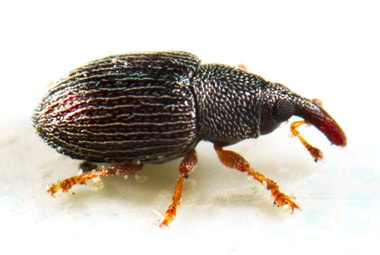
Rice weevils are a species of stored product pest that are found living throughout the world; in the United States they are mainly found in southern states that have warmer climates. They are named because when first discovered they were mainly associated with whole grain rice.
| Pest Identification | |
|---|---|
| Recognition | Rice weevils are small; adults only grow to only be about 1/10 of an inch in length. They are reddish-brown to black with four yellow or reddish spots on the corners of the forewings, and many round pits on the thorax. Rice weevils are winged and capable of flight. They also have a distinctive “snout” that is 1/3 of its total body length. Their larvae are legless and fat with a dark head capsule and a cream-colored body. |
| Biology | The female rice weevil will lay (on average) 4 eggs per day over her lifespan of 4-5 months. The female chews a hole into a kernel of grain and then seals the hole with a gooey substance that she produces. The eggs hatch in approximately 3 days, the larvae stay inside of the grain and feed for the next 18 days. They then enter the pupal stage for about 6 days. After the adult emerges from the pupa it will stay in the grain kernel for another 3-4 days while its body hardens and it matures a bit more before emerging from the kernel of grain. |
| Habits | Rice weevils are a serious stored product pest, and if left unchecked, they have the ability to compromise food supplies on a massive scale. They are known to contaminate bird seed (specifically sunflower seeds), corn, wheat, rice, beans, nuts, cereals, stored cotton, along with grapes, apples, and pears. In southern states, adults may infest crops out in the fields and contaminate food processing facilities when the infested crops are brought in. They are strong fliers and are attracted to light. If the adults are disturbed, they play dead by bringing up their legs against their body and falling over. Rice weevils often infest the pantries of homeowners when the homeowners unknowingly purchase products from the store that are already infested. |
| Prevention | In order to prevent your pantry and home from becoming infested with these stored product pests, you should always inspect food and food packaging for signs of rice weevil activity before purchasing them from the store. Make sure to store grains in sealed plastic or glass containers with tight-fitting lids, and regularly rotate dry goods in your pantry, getting rid of older or expired items. Routinely clean up spills and clean crumbs from cabinet and pantry areas. It is also a good idea to make sure that screens in windows and doors are intact. You should also caulk gaps found around exterior windows and doors to help prevent adults from flying into your home. |
| Professional | The most effective way to control rice weevils in your home is through the help of a professional pest control expert. At Rottler Pest & Lawn Solutions, a trained technician will inspect for these pests and areas where they are hiding, breeding and living. If treatment for these pests is needed, services may include a crack and crevice treatment using a non-residual aerosol insecticide to eliminate adult rice weevils that may be concealed in structural seams and crevices of cabinets and shelving. |

